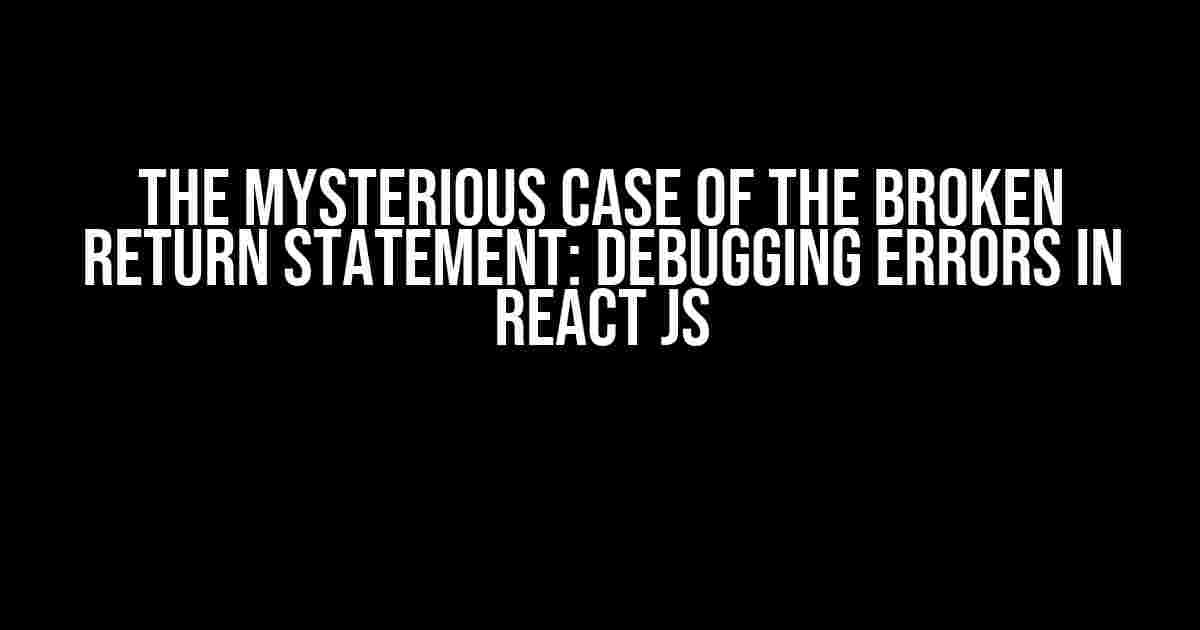Are you tired of banging your head against the wall because your return statement isn’t working as expected in React JS? You’re not alone! In this article, we’ll embark on a thrilling adventure to uncover the common culprits behind this frustrating error and provide you with actionable solutions to get your return statement up and running.
Understanding the Return Statement in React JS
In React, the return statement is used to specify the output of a function component. It’s a crucial part of the component’s lifecycle, as it determines what’s rendered to the DOM. A typical React function component looks like this:
import React from 'react';
function MyComponent() {
return <div>Hello World!</div>;
}
export default MyComponent;
In this example, the return statement is used to return a JSX element, which is then rendered to the DOM.
Common Errors Causing the Return Statement to Fail
So, what could be causing your return statement to throw an error? Let’s explore some common culprits:
1. Incorrect JSX Syntax
JSX is a syntax extension for JavaScript that allows you to write HTML-like code in your JavaScript files. However, JSX is not HTML, and it has its own set of rules. A common mistake is to use incorrect syntax, such as:
import React from 'react';
function MyComponent() {
return Hello World! >;; // Incorrect syntax
}
export default MyComponent;
In this example, the JSX syntax is incorrect, which will result in an error. The correct syntax would be:
import React from 'react';
function MyComponent() {
return <div>Hello World!</div>;
}
export default MyComponent;
2. Missing or Incorrect Import Statements
In React, you need to import React and other dependencies explicitly. Failing to do so can cause errors, including issues with the return statement:
function MyComponent() {
return Hello World!; // Missing React import
}
export default MyComponent;
The correct code would be:
import React from 'react';
function MyComponent() {
return <div>Hello World!</div>;
}
export default MyComponent;
3. Incorrect Function Definition
In React, function components must be defined as functions, not as classes. A common mistake is to define a function component as a class:
class MyComponent {
render() {
return Hello World!; // Incorrect function definition
}
}
export default MyComponent;
The correct code would be:
import React from 'react';
function MyComponent() {
return <div>Hello World!</div>;
}
export default MyComponent;
4. Conditional Statements and the Return Statement
When using conditional statements, such as if-else statements or ternary operators, it’s essential to ensure that the return statement is properly handled. A common mistake is to forget to return a value in one of the conditional branches:
import React from 'react';
function MyComponent() {
if (true) {
return Hello World!;
} // Missing return statement
}
export default MyComponent;
The correct code would be:
import React from 'react';
function MyComponent() {
if (true) {
return Hello World!;
} else {
return Else Clause; // Ensure a return statement in all branches
}
}
export default MyComponent;
Troubleshooting and Debugging Techniques
Now that we’ve covered some common errors, let’s dive into some troubleshooting and debugging techniques to help you identify and fix issues with your return statement:
1. Enable Debug Mode in React
In React, you can enable debug mode to get more detailed error messages. To do this, add the following line of code to your index.js file:
import { enableDebug } from 'react';
enableDebug(true);
2. Use the React DevTools
The React DevTools provide a range of debugging tools, including the ability to inspect component props, state, and context. You can access the DevTools by pressing Ctrl + Shift + I (Windows/Linux) or Command + Shift + I (Mac) in your browser.
3. Utilize Console Logs and Alerts
Adding console logs and alerts can help you understand the flow of your code and identify where issues are occurring. For example:
import React from 'react';
function MyComponent() {
console.log('Component rendered'); // Add console log
return <div>Hello World!</div>;
}
export default MyComponent;
4. Use a Code Editor with Syntax Highlighting
A code editor with syntax highlighting can help you identify syntax errors and typos in your code. Popular code editors include Visual Studio Code, IntelliJ IDEA, and Sublime Text.
Best Practices for Return Statements in React JS
To avoid common errors and ensure your return statement is working correctly, follow these best practices:
1. Use Consistent JSX Syntax
Stick to a consistent JSX syntax throughout your code. This will help you avoid errors and make your code easier to read.
2. Define Functions Correctly
Ensure that your function components are defined correctly, using the `function` keyword, and that they return a valid JSX element.
3. Use Conditional Statements Wisely
When using conditional statements, ensure that the return statement is properly handled in all branches.
4. Use Debugging Tools and Techniques
Enable debug mode in React, use the React DevTools, and utilize console logs and alerts to identify and fix issues with your return statement.
Conclusion
In this article, we’ve explored the common errors and pitfalls that can cause the return statement to fail in React JS. By following the best practices outlined above and utilizing debugging techniques, you’ll be well-equipped to identify and fix errors in your return statement. Remember, a well-crafted return statement is crucial to rendering the correct output in your React application.
| Error | Cause | Solution |
|---|---|---|
| Incorrect JSX Syntax | Incorrect use of JSX syntax | Ensure consistent JSX syntax throughout your code |
| Missing or Incorrect Import Statements | Failing to import React and other dependencies | Always import React and other dependencies explicitly |
| Incorrect Function Definition | Defining a function component as a class | Define function components using the `function` keyword |
| Conditional Statements and the Return Statement | Forgetting to return a value in one of the conditional branches | Ensure a return statement in all conditional branches |
By applying these solutions and best practices, you’ll be able to overcome the frustrating errors that can occur with the return statement in React JS. Happy coding!
Here are 5 Questions and Answers about “Return statement isn’t working and is giving an error in React JS”:
Frequently Asked Question
Hey there, React enthusiasts! Are you stuck with a pesky return statement error in React JS? Well, you’re in luck because we’ve got the answers to your questions!
Why is my return statement not working in React JS?
Hey, buddy! Make sure you’re not using a return statement outside a function or inside a JSX element. In React, return statements are only valid inside functions, so double-check your code and ensure you’re using it correctly!
I’m getting a syntax error when using a return statement in my React component. What’s going on?
Oops, sounds like you’ve got a syntax issue! Check if you’ve forgotten to close a bracket, paren, or curly brace. Also, ensure you’re not using a return statement inside an object or an array. If you’re still stuck, try rewriting your code or checking the React documentation for guidance!
Can I use a return statement in a React functional component?
Yes, you can! In React functional components, you can use a return statement to return JSX elements. Just remember to keep your return statement inside the function body and ensure it’s not nested inside another element or object. Easy peasy!
I’m trying to return an array of elements in React, but it’s giving me an error. What’s the deal?
Ah-ha! When returning an array of elements, React requires you to wrap them in a single parent element, like a div or a fragment (<>). This is because React only allows one top-level element per component. So, try wrapping your array of elements in a parent element, and you should be good to go!
How can I troubleshoot my return statement issue in React JS?
Debugging 101! Start by checking the console for error messages, which can give you a hint about what’s going wrong. Next, try isolating the problematic code by commenting out sections or using the React DevTools to inspect your component. Finally, review the React documentation and search for similar issues online. With persistence and patience, you’ll track down that error in no time!
I hope you found these questions and answers helpful in resolving your return statement issues in React JS!



